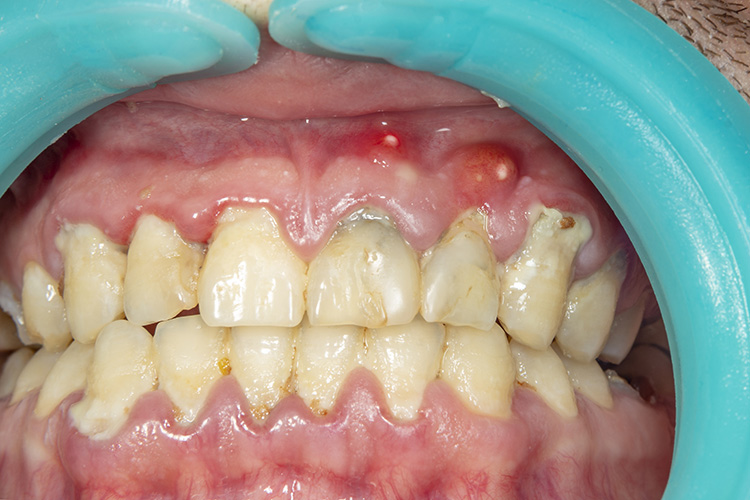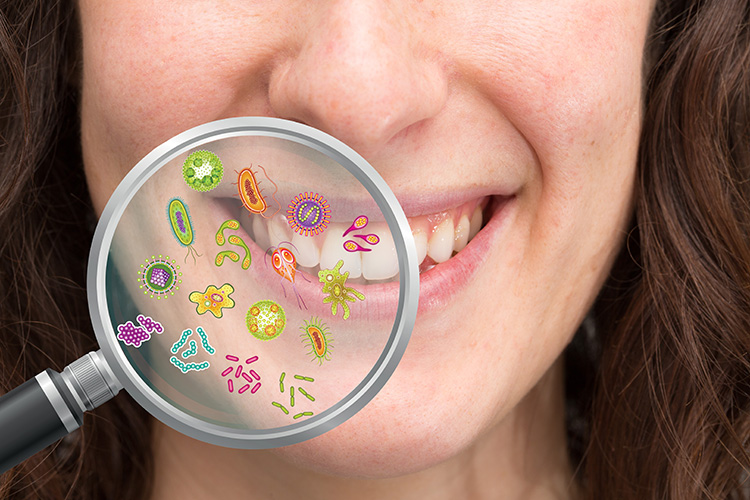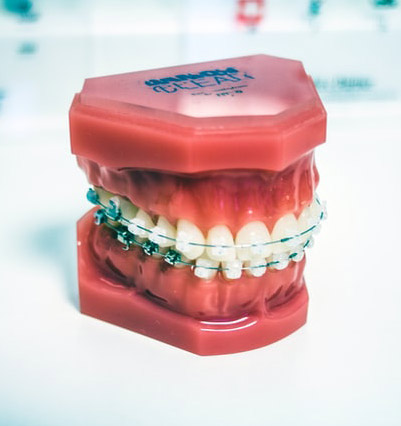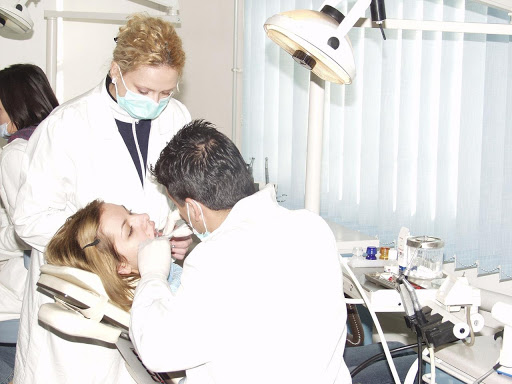How Common Is Periodontal Disease?
 Periodontal disease affects about 20%-50% of the world’s population. And more predominantly among the older population in high-income countries. According to the American Academy of Periodontology, periodontal disease is a chronic inflammatory disease. It affects the gum tissue and bone supporting the teeth.
Periodontal disease affects about 20%-50% of the world’s population. And more predominantly among the older population in high-income countries. According to the American Academy of Periodontology, periodontal disease is a chronic inflammatory disease. It affects the gum tissue and bone supporting the teeth.
Sadly, this is a very common problem among adolescents and adults alike. Therefore, it must be treated with special care by a periodontist.
This article walks you through the prevalence of periodontal disease among different populations, symptoms, causes, and more.
Prevalence of Periodontal Disease in Adults in the United States
According to a recent CDC (Centers for Disease Control and Prevention) study, 47.2 % of U.S. adults have periodontitis, a more advanced form of periodontal disease. This means that 64.7 million Americans have periodontal disease. Half of those above 30 and above have severe periodontal disease. The same study states that prevalence rates increase to 70.1 percent among adults 65 years and older. These findings are based on the data collected as a part of the 2009-2010 National Health and Nutrition Examination Survey (NHANES).
These findings suggest that more people have periodontal disease than previously thought. And there is a disparity among specific population groups. For example, at 56.4%, the disease is higher among men than women, 38.4%. In addition, the rate is highest among Mexican Americans at 66.7% when compared to other races. The other segments that see a high prevalence of periodontal disease include smokers, people living under the federal poverty level, and less education.
Is Periodontitis a Serious Disease?
Contrary to popular myth, periodontitis in adults is extremely common. It is a severe infection of the tissues that surround and support your teeth. If left untreated, it can lead to tooth loss and other health complications, including increasing one’s risk for oral cancer.
The bacteria causing periodontal disease can enter the bloodstream affecting other parts of the body. As the disease progresses, it can lead to rheumatoid arthritis, respiratory disease, heart disease, and diabetes.
Diagnosing Gum Disease
Firstly, periodontists rely on visual assessment to check the patient’s oral health. But, this visual method of diagnosing indicates only the presence of the disease. To assess the severity of periodontitis, you need to rely on more advanced diagnostic methods to determine Clinical Attachment Loss (CAL) or Radiographic Bone Loss (RBL). The periodontist then measures the pocket depth with a periodontal probe. A depth of 4mm indicates the presence of periodontal disease. Pockets deeper than 5 mm may indicate severe periodontitis and cannot be cleaned well.
New tests offer genetic and biological information to better determine the appropriate treatment regimen for each patient.
Can You Reverse Gum Disease?
Periodontal disease is broken into four stages:
- Gingivitis
- Slight Periodontal Disease
- Moderate Periodontal Disease
- Advanced Periodontal Disease (Periodontitis)
Of these, gingivitis is the only stage that can be reversed as the bacteria has not yet had time to attack the bones. However, once a patient reaches stage 2, the infection has already spread to the bones, possibly destroying them. At this stage, the disease is only manageable and not preventable.
Hence, it is vital to catch periodontal diseases early before they move on to peridontitis.
At What Age Do Most People Get Gum Disease?
The chance of periodontal disease increases as you grow older. That is why it is most commonly seen in older adults. For example, clinical attachment loss was significantly higher among adults of ages 60 to 69 years when compared with those aged 40-50 years.
Due to the slow nature of the disease, it can even develop early in life and can go undetected until the patient is older. Unfortunately, by this time, a great deal of damage would have happened.
Causes and Symptoms of Periodontal Disease
Periodontal disease is an inflammatory condition that affects the tissues and bones surrounding the teeth. The early stage is called gingivitis. During this period the gums become red and swollen, a clear sign of bacterial infection. In the more severe cases, the gums pull away from the tooth. In chronic periodontitis i.e, the advanced stage, you may witness a loss of gum tissue and bones, resulting in the teeth falling off. The disease, however, progresses pretty slowly.
 Causes
Causes
Periodontal disease is quite common but preventable. The prevalence of periodontitis can be attributed to poor oral health and hygiene. Generally, oral diseases like periodontal disease start with the development of plaque.
- Sugars and starch in your food, together with the bacteria in your mouth, form a film called plaque.
- The plaque hardens into tartar under your gumline. It is filled with bacteria and is difficult to move at this point. You need a dental cleaning to get rid of it.
- Plaque causes gum disease or otherwise called gingivitis which is the inflammation of the gums. Good dental care and treatment can reverse the disease at this stage.
- Ongoing gum inflammation leads to periodontitis, a form of severe periodontal disease. This causes pockets to form your teeth and gums. These eventually fill with plaque, tartar, and bacteria. If not treated, they can lead to loss of tissue and bone, with your teeth falling off.
Symptoms
The first thing to remember is that healthy gums generally are pink and fit snug around your teeth. So even though the signs of periodontal disease are pretty subtle, it is not entirely without any warning.
The symptoms of periodontal disease include:
- Gum Inflammation
- Red and Tender Gums
- Pus Between Teeth and Gums
- Spaces Developing Between Teeth
- Bleeding Gums (Especially While Brushing and Flossing)
- Halitosis (Chronic Bad Breath)
- Change in Bite
- Receding Gum Lines
- Calculus (Plaque or Tartar Buildup)
- Pain when Biting or Chewing
- Loose Teeth or Loss of Teeth
- Foul Taste in the Mouth
- Inflammatory Response
Risk Factors
Research shows that gum disease is associated with other systemic diseases such as diabetes and cardiovascular disease (CVD). Several factors increase the risk of periodontal diseases. The risk factors can be both modifiable and non-modifiable.
Modifiable Risk Factors
- Smoking & Tobacco Use – Smoking is of the leading factors for periodontal disease. Furthermore, it also affects oral microbial flora. Smokers are three times more likely to have severe periodontal disease than non-smokers. They also have more chances of tooth loss, alveolar bone loss, and poor outcomes of all forms of treatments. Moreover, nicotine can directly or indirectly cause periodontal tissue breakdown. Smokers with periodontal disease can develop cancerous lesions in the future.
- Poor Oral Hygiene – Poor dental health aids bacterial deposition and build-up of dental plaque, leading to inflammation in periodontal tissues. Due to this, there is a high prevalence and increased severity of periodontal disease.
- Hormonal Changes in Females – The increased progesterone during mensuration and ovulation disrupts the repair of collagen fiber and causes the blood vessels to dilate. Similarly, pregnant women also show signs of gingivitis. Finally, estrogen deficiency also reduces bone density leading to bone loss.
- Diabetes Mellitus – Diabetes mellitus can play a significant role in the initiation and progression of periodontal disease. It is also associated with periodontal ligament destruction leading to loss of teeth.
- Medications – Medicines like tricyclic antidepressants, atropine, antihistamine, and beta-blockers can reduce saliva flow. This leaves the patient vulnerable to periodontal disease.
- Stress – Stress reduces the flow of salivary secretions, which leads to increased dental plaque formation. People under stress can have poor oral hygiene. Furthermore, depressed individuals can have a higher cortisol concentration in the gingival crevicular fluid. And hence may respond poorly to treatment.
Non-Modifiable Risk Factors
Age – Older adults have increases chances of periodontal disease than other age groups.
Heredity – Genetics, along with environmental and demographical determinants, increase the threat of periodontal disease among different racial and ethnic populations.
Can You Stop Periodontitis?
Severe periodontal disease is called Periodontitis. At this point, it starts damaging the bone and is not reversible. However, your periodontist can treat and stop the progression of the disease. Gingivitis and mild cases require non-surgical treatment by a general dentist. However, moderate and severe periodontitis requires a surgical intervention to save as many teeth as possible.
 With proper treatment and good oral health practices, periodontitis is manageable.
With proper treatment and good oral health practices, periodontitis is manageable.
- Brush twice a day, for at least 2 minutes every time.
- Floss once a day.
- Stop smoking and tobacco use.
- Maintain a healthy diet.
- Limit acidic and sugary foods.
- Regular dental cleanings and exams can help spot the disease early.
Conclusion
According to World Health Organization (WHO), developing countries have a high prevalence of calculus and bleeding gums among adolescents. 35% to 70% of those in developing countries have calculus deposits, while 4% to 34% in the developed nations.
Centers for Disease Control and Prevention (CDC) is currently working with organizations such as the American Academy of Periodontology and the American Dental Association to improve the surveillance of periodontal disease in the adult U.S. population. In addition to that, state and local authorities should implement oral health policies to reduce the burden of disease and improve the quality of life of people.
Furthermore, the American Academy of Periodontology recommends a comprehensive periodontal evaluation every year. Your dentist can perform it at your bi-annual check-up.
One of the best dentists in the Tucson area is Dr. Dalesandro, who has the experience you want to help you with gum disease or any other dental problems; call today for your next appointment.
 Can decayed teeth be fixed? First let’s discuss tooth decay briefly. Tooth decay is a process that happens over time. Untreated tooth decay will become cavities. There are hundreds of different kinds of bacteria in the mouth, which you can read more about in this
Can decayed teeth be fixed? First let’s discuss tooth decay briefly. Tooth decay is a process that happens over time. Untreated tooth decay will become cavities. There are hundreds of different kinds of bacteria in the mouth, which you can read more about in this 
 Whether large or small, odds are if you have gaps or misalignments in your teeth, you’ll need braces. They are a corrective dental device used to realign and posture your teeth in the proper order.
Whether large or small, odds are if you have gaps or misalignments in your teeth, you’ll need braces. They are a corrective dental device used to realign and posture your teeth in the proper order. Root canals are commonly performed on individuals suffering from severe teeth rot due to cavities or other conditions. By the time you get to the root canal phase, it’s not an optional procedure; it’s mandatory. Root canals are also required when your teeth become infected to where natural tooth decay will occur.
Root canals are commonly performed on individuals suffering from severe teeth rot due to cavities or other conditions. By the time you get to the root canal phase, it’s not an optional procedure; it’s mandatory. Root canals are also required when your teeth become infected to where natural tooth decay will occur.

 Why Be Concerned About Your Dental and Oral Health?
Why Be Concerned About Your Dental and Oral Health?